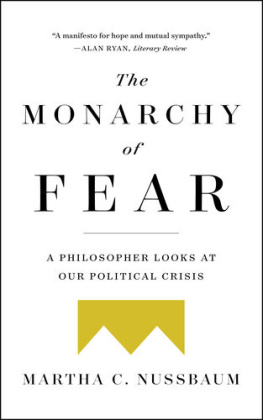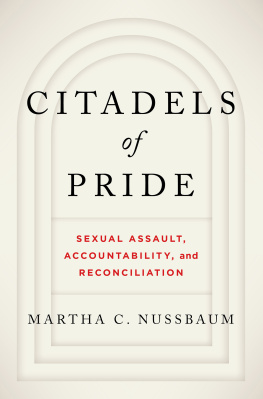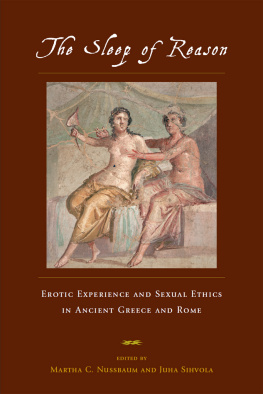Hiding from Humanity
Hiding from Humanity
Disgust, Shame, and the Law
MARTHA C. NUSSBAUM
Princeton University Press
Princeton and Oxford
Copyright 2004 by Princeton University Press
Published by Princeton University Press,
41 William Street, Princeton, New Jersey 08540
In the United Kingdom: Princeton University Press,
3 Market Place, Woodstock, Oxfordshire OX20 1SY
All Rights Reserved
Library of Congress Cataloging-in-Publication Data
Nussbaum, Martha Craven, 1947
Hiding from humanity : disgust, shame, and the law / Martha C. Nussbaum.
p. cm.
Includes bibliographical references and index.
ISBN 0-691-095264 (alk. paper)
1. LawPsychological aspects. I. Title.
K346.N87 2004
340'.1'9dc22 2003061013
British Library Cataloging-in-Publication Data is available
This book has been composed in New Baskerville
Printed on acid-free paper.
www.pup.princeton.edu
Printed in the United States of America
1 3 5 7 9 10 8 6 4 2
For David Halperin
O my body! I dare not desert the likes of you in other men and
women, nor the likes of the parts of you,
I believe the likes of you are to stand or fall with the likes of the
soul, (and that they are the soul,)
I believe the likes of you shall stand or fall with my poems,
and that they are my poems.
Walt Whitman, I Sing the Body Electric, 9.129131
Human beings are not by nature kings, or lords, or courtiers, or rich. All are born naked and poor; all are subject to the miseries of life, to sorrows, ills, needs, and pains of every kind. Finally, all are condemned to death. It is the weakness of the human being that makes us sociable; it is our common miseries that turn our hearts to humanity; we would owe humanity nothing if we were not human. Every attachment is a sign of insufficiency. If each of us had no need of others, he would hardly think of uniting himself with them. Thus from our weakness our fragile happiness is born. I do not conceive how someone who needs nothing can love anything. I do not conceive how someone who loves nothing can be happy.
Jean-Jacques Rousseau, Emile, Book IV
The alarming thing about equality is that we are then both children, and the question is, where is father? We know where we are if one of us is the father.
B, patient of Donald Winnicott, analysis published as Holding and Interpretation
Contents
Acknowledgments
This book began as the Remarque Lectures, delivered at the Remarque Institute at New York University in March 2000. I owe thanks to Tony Judt, the institutes director, for the invitation and the occasion to present material to a very stimulating audience. Jair Kessler was an invaluable support in the practical arrangements surrounding the visit.
The general chapter on emotions and law draws on an article, Two Concepts of Emotion in Criminal Law, that Dan M. Kahan and I published in the Columbia Law Review (96 [1996], 269374). I am most grateful to Kahan for getting me started on this track years ago, and for the unfailing helpfulness and intelligence of his contributions on the topic. The present book is in large part a record of disagreements that increasingly emerged as we pursued our common interest, and therefore may seem to contain a rather large measure of criticism of Kahan. I should make clear, however, the large amount it owes, as well, to his insight and energy.
The material on disgust began as a review of William Millers The Anatomy of Disgust, in the New Republic. I am very grateful to Miller for provoking my reactions by his insightful work, and for generous comments on the work in progress. The work then took shape as an article in a volume on emotions in the law edited by Susan Bandes (Secret Sewers of Vice: Disgust, Bodies, and the Law, in The Passionsof Law [New York: New York University Press, 1999], 1962). I am most grateful to Bandes for encouraging me to begin this project. The paper has been presented as a Katz Lecture at the University of Chicago Law School, and at quite a few other universities. The material on shame has also been presented at a number of occasions, including the American Society for Political and Legal Philosophy at the Eastern Division of the American Philosophical Association, and as the Kadish Lecture at Boalt Hall, University of California. For formal comments on the former occasion, I am grateful to Dan Kahan and Sandy Levinson; for comments at the latter, I am grateful to Seana Shiffrin and Chris Kutz. The manuscript in progress was also presented as a series of lectures at Syracuse University and as the Hourani Lectures at SUNY-Buffalo.
For very helpful comments on these and other occasions, or in response to reading a draft, I am most grateful to Kate Abramson, Louise Antony, Marcia Baron, Michael Blake, John Brademas, John Braithwaite, Talbot Brewer, Susan Brison, Alisa Carse, Peter Cicchino, Ruth Colker, Richard Craswell, John Deigh, Joshua Dressler, Barbara Fried, Robert Goodin, Virginia Held, Dan M. Kahan, Mark Kelman, Benjamin Kilborne, Carolyn Korsmeyer, Maggie Little, Tracey Meares, Winfried Menninghaus, Jeffrie Murphy, Charles Nussbaum, Rachel Nussbaum, Eric Posner, Richard Posner, Bernard Reginster, Deborah Rhode, Sibyl Schwarzenbach, Nancy Sherman, Jerry Siegel, Laura Slatkin, Marc Spindelman, Gopal Sreenivasan, Michael Stocker, Cass Sunstein, David Velleman, and James Whitman.
Three readers of the manuscript for the Princeton University Press supplied invaluable written comments: Seana Shiffrin, Robin West, and an anonymous reviewer. I thank them warmly, and I also thank Mitchell Berman, Dan Markel, Cass Sunstein, and Stephen Schulhofer, who did the same at a later stage.
Finally, I was lucky enough to have wonderful research assistance at various stages in the genesis of the project. I am exceedingly grateful to Sonya Katyal, Felise Nguyen, and Mark Johnson for their energy and creativity.
This book is dedicated to my long-time friend, David Halperin, scholar and activist, one of the founders of the rigorous academic study of sexual orientation. Although I know that he disagrees with a lot that is in it, both methodologically and substantively (as I disagree with some of what he writes), our disagreements over the years, and our agreements, have been undergirded both by my deep gratitude for the experience of being understood and seen, which is very rare in friendship, and which I hope is in some sense reciprocal, and by a passionate shared commitment to equal human dignity.
Hiding from Humanity
Introduction
I. Shame and Disgust: Confusion in Practice and Theory
A California judge orders a man convicted of larceny to wear a shirt stating, I am on felony probation for theft. In Florida, convicted drunk drivers are required to display bumper stickers reading Convicted D.U.I. Similar stickers have been authorized in other states, including Texas and Iowa. Penalties like these, involving public shaming of the offender, are becoming increasingly common as alternatives to fines and imprisonment.
Jamie Brub was born with Down syndrome. As a result of changes enacted under the Individuals with Disabilities Education Act, he has an Individualized Education Plan that provides for him to be mainstreamed in a regular public school classroom, albeit with a monitor. The teacher and monitor work to ensure that Jamie need not live as a shamed and stigmatized person, and his condition need no longer be the object of humiliation.
In a 1973 opinion that still defines the law of obscenity, Chief Justice Warren Burger wrote that the obscene must be defined in a manner that includes reference to the disgust and revulsion that the works in question would inspire in the average person, applying contemporary community standards. To make the connection to disgust even clearer, Justice Burger added a learned footnote about the etymology of the term from Latin
Next page







